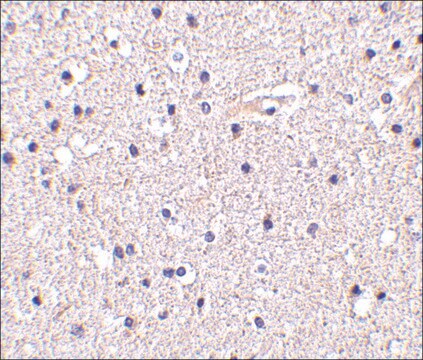MAB5556
Anti-Nicastrin Antibody
ascites fluid, clone 9C3, Chemicon®
About This Item
Prodotti consigliati
Origine biologica
mouse
Livello qualitativo
Forma dell’anticorpo
ascites fluid
Tipo di anticorpo
primary antibodies
Clone
9C3, monoclonal
Reattività contro le specie
rat, human, mouse
Produttore/marchio commerciale
Chemicon®
tecniche
immunocytochemistry: suitable
immunoprecipitation (IP): suitable
western blot: suitable
Isotipo
IgG2b
N° accesso NCBI
N° accesso UniProt
Condizioni di spedizione
dry ice
modifica post-traduzionali bersaglio
unmodified
Informazioni sul gene
human ... NCSTN(23385)
Specificità
Immunogeno
Applicazioni
Immunocytochemistry
Immunoprecipitation. Suggested tissue/cell lysis buffer is 1% Triton X100 or 2% CHAPS. Suggested final reaction volume is 1000 μL with a final protein concentration in the reaction mix of 1 mg/mL. Suggested incubation time is overnight at 2-8°C with rotating. The antibody is known to co-precipitate in CHAPS: presenilin, Aph-1 and Pen-2. Optimal working dilutions must be determined by end user.
Note legali
Not finding the right product?
Try our Motore di ricerca dei prodotti.
Codice della classe di stoccaggio
10 - Combustible liquids
Classe di pericolosità dell'acqua (WGK)
WGK 1
Punto d’infiammabilità (°F)
Not applicable
Punto d’infiammabilità (°C)
Not applicable
Certificati d'analisi (COA)
Cerca il Certificati d'analisi (COA) digitando il numero di lotto/batch corrispondente. I numeri di lotto o di batch sono stampati sull'etichetta dei prodotti dopo la parola ‘Lotto’ o ‘Batch’.
Possiedi già questo prodotto?
I documenti relativi ai prodotti acquistati recentemente sono disponibili nell’Archivio dei documenti.
Il team dei nostri ricercatori vanta grande esperienza in tutte le aree della ricerca quali Life Science, scienza dei materiali, sintesi chimica, cromatografia, discipline analitiche, ecc..
Contatta l'Assistenza Tecnica.








